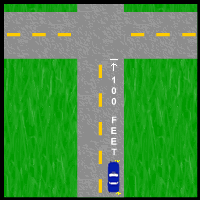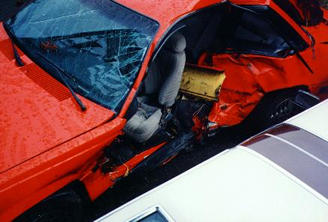|
There are three types of turns you will be making at
intersections: right, left, and U-turns. They all have rules
in common, including the need for signaling. Nobody is
reading your mind out there, so you need to let the other guy
know what you're planning to do. How else can he make plans
to allow for your vehicle?
|
 |
Begin signaling 100 feet before you plan to turn (A).
That's about 2 1/2 to 3 house lots.
This is a much greater distance than most people allow
for. If you are the person who clicks your signal once
or twice as you're making a turn, you are not protecting
yourself, physically or legally, if you are rear-ended.
|
 |
| (A) |
|
 |
Check
for hazards: bicycles, other cars, and pedestrians.
|
 |
Make sure there are no signs prohibiting
the turn you want to make.
|
 |
Stop behind the thick white line and look left, right,
and left again. Even if your turn is protected by a
signal, you must make sure the way is clear for your
vehicle. Yes, the other guy may be in the intersection
illegally, but are you going to prove the point by
risking your life?
|
 |
If your
view is blocked, wait until you can see clearly, or change
your plans. Go to the next light, find another parking
space, do whatever you can to avoid making a blind turn.
|
 |
| Even when you have a green light,
look both ways before crossing an intersection. Notice
the mangled driver's seat from impact. |
|
 |
Start as near to the edge of the
road or curb as possible, and maintain your lane position during and
after the turn. Other cars are expecting
you to do this, and will not be preparing to yield to
you. |
|
|



